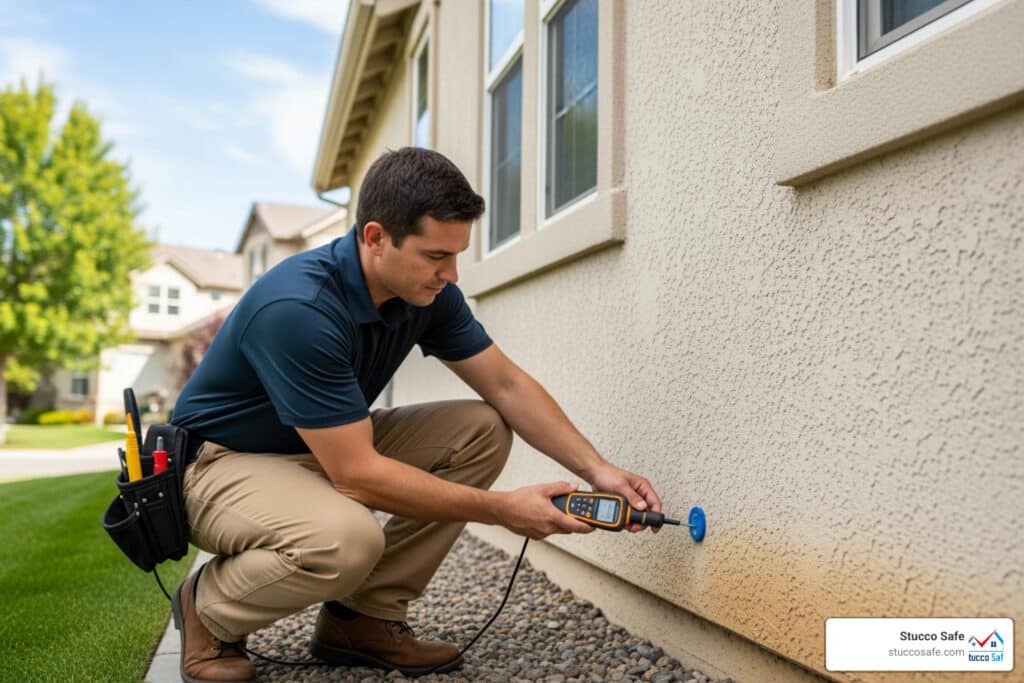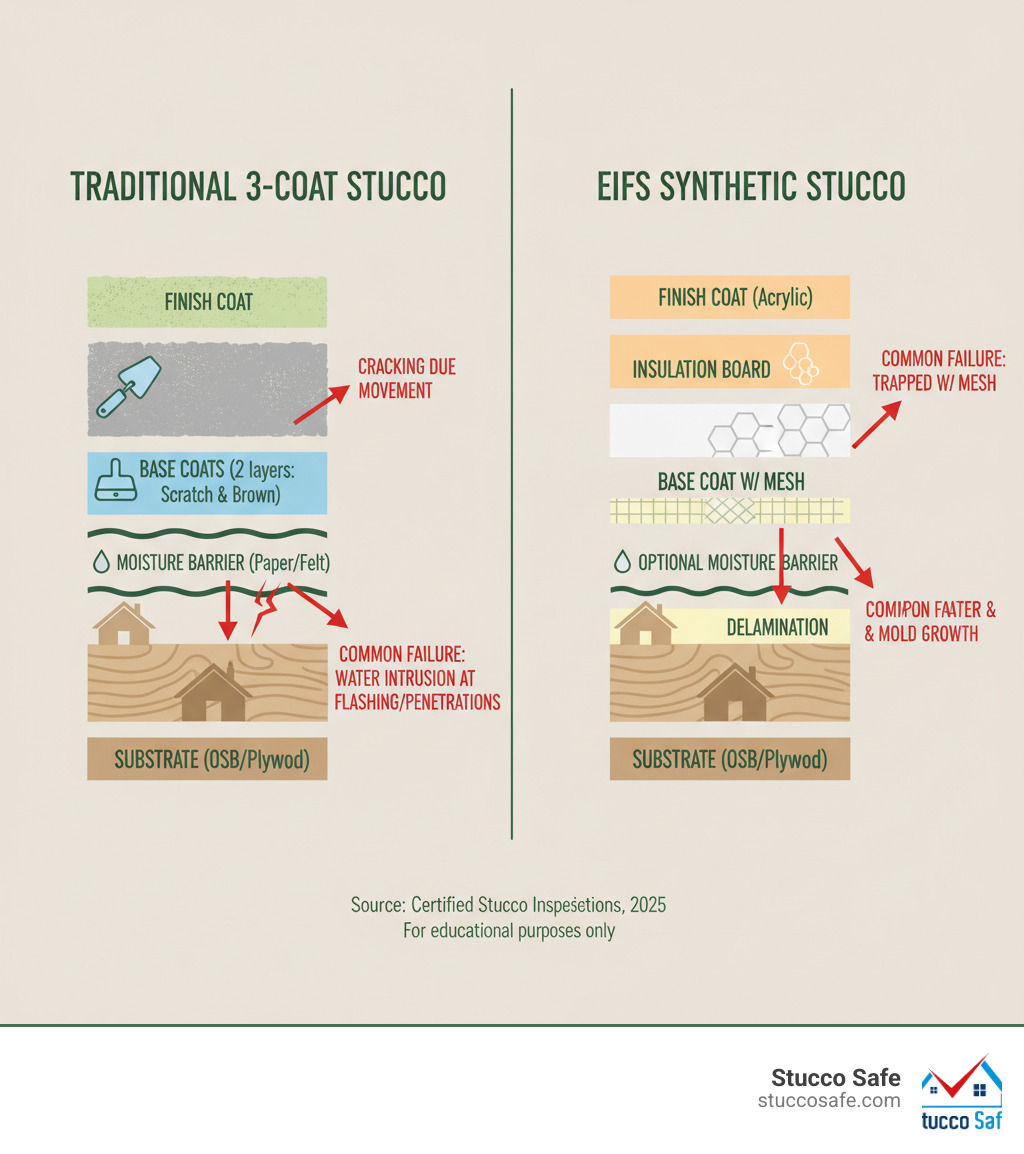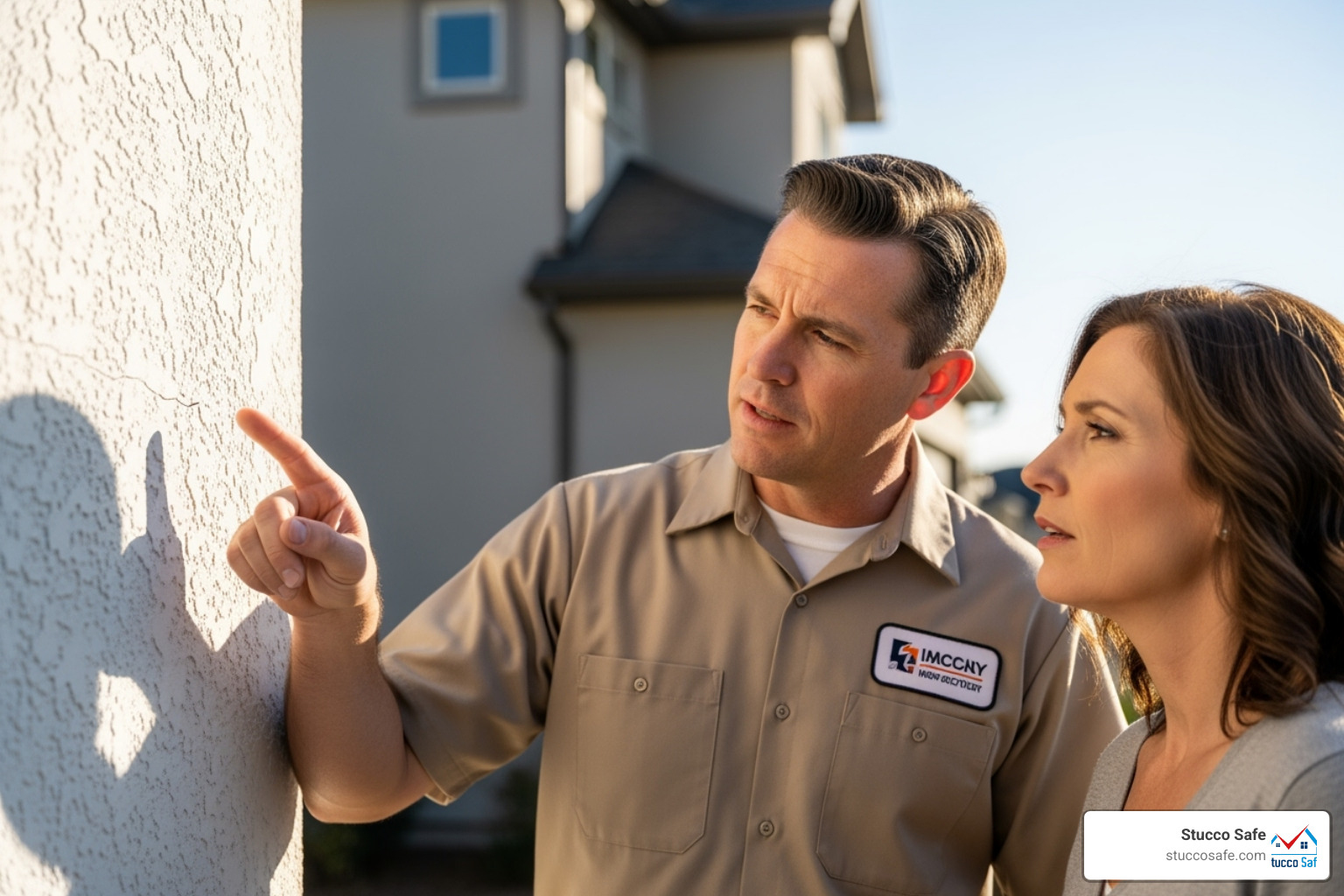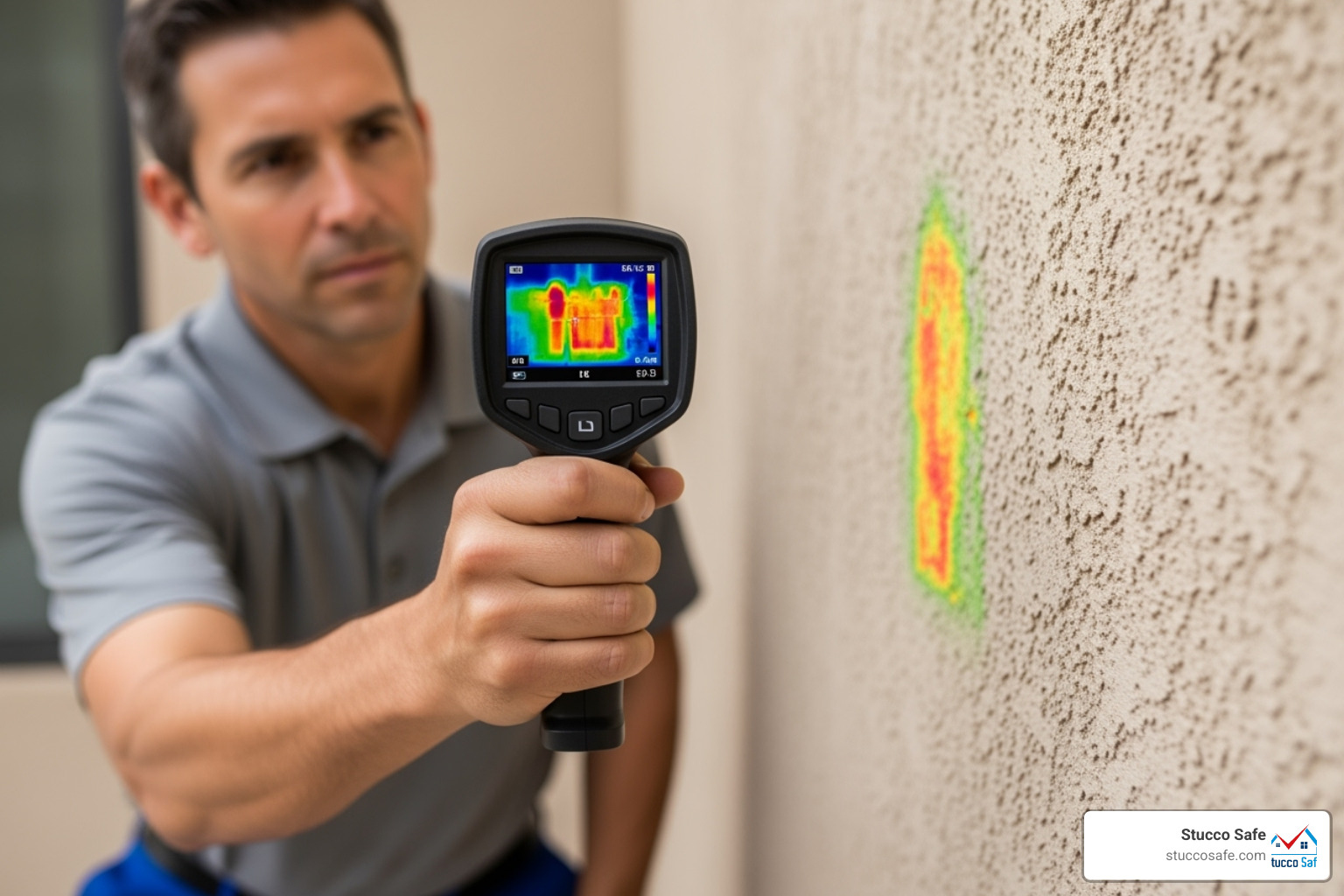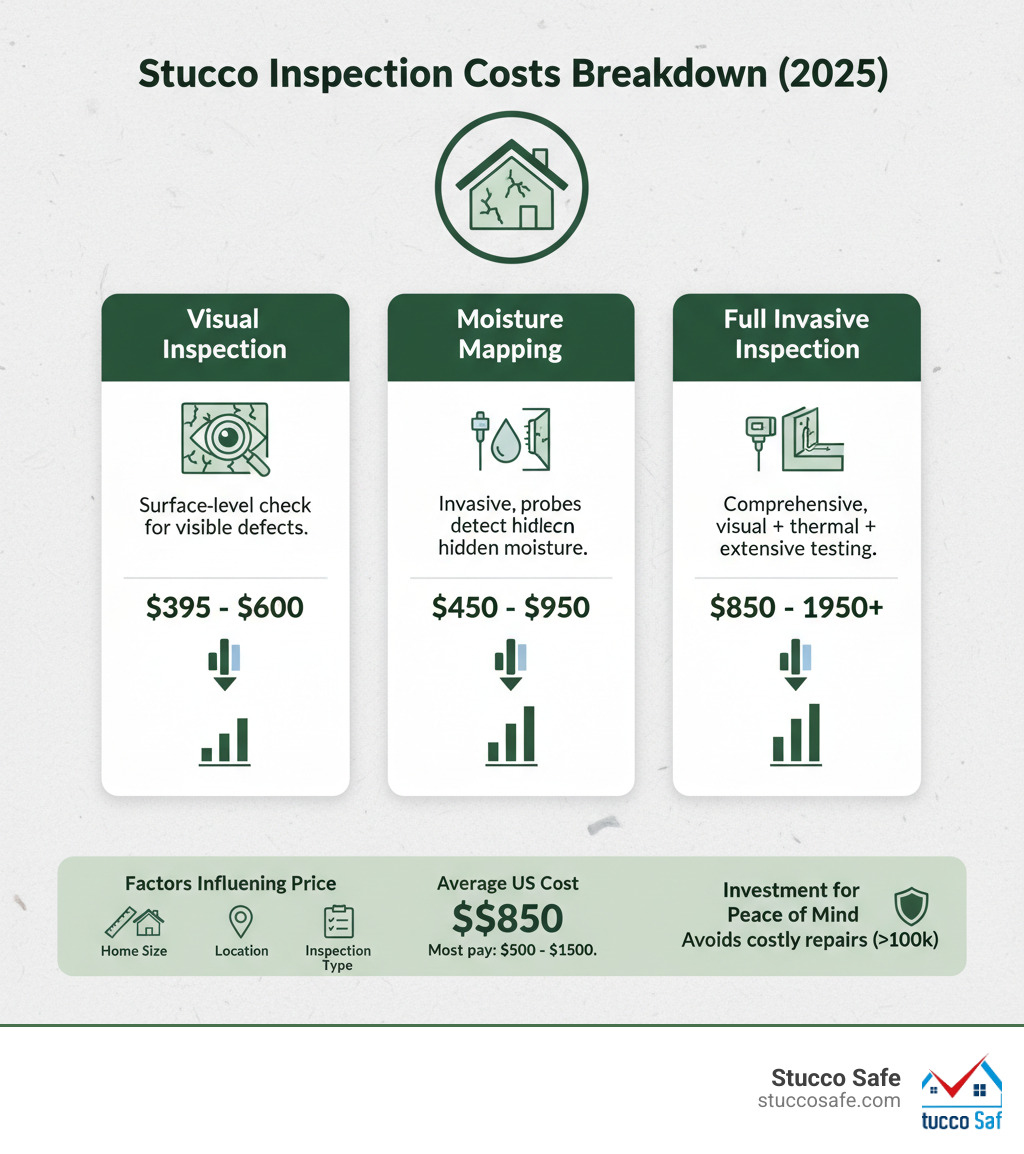Certified Stucco Inspections: Avoid 90% Failure
Why Understanding Certified Stucco Inspections Is Critical for Your Home
Certified stucco inspections are professional evaluations by trained specialists who use advanced testing to find hidden moisture damage and structural issues behind stucco exteriors. Costing between $495 to $1,595+, these inspections reveal problems invisible to the naked eye.
What Certified Stucco Inspections Include:
- Visual assessment of cracks, stains, and surface damage
- Thermal imaging to detect temperature variations indicating moisture
- Invasive moisture testing using specialized probes and meters
- Comprehensive reporting with photographs and repair recommendations
- Substrate evaluation to assess structural integrity behind the stucco
The numbers tell a sobering story: more than 90% of stucco applications installed in the past 15 to 30 years are estimated to be defective. This staggering failure rate means a beautiful exterior could be hiding thousands of dollars in water damage.
Stucco failures are often invisible, making professional evaluation essential for protecting your investment and ensuring your family’s safety, especially for homeowners in areas like Southeastern Pennsylvania. As a certified inspector with experience since 2001, I’ve seen how early detection through certified stucco inspections saves homeowners from catastrophic repair costs.
The Critical Role of a Stucco Inspection
A certified stucco inspection is a health checkup for your home’s exterior. A trained professional investigates what’s happening behind the walls, checking for moisture intrusion, structural issues, and installation defects.
With over 90% of recent stucco installations showing defects, a beautiful exterior can hide expensive problems. Many homeowners only find major damage after water has been quietly destroying their home’s structure for years.
Why Professional Inspections Matter
Preventing costly repairs is the primary benefit. A small moisture problem caught early may cost a few hundred dollars to fix, while waiting until water rots the sheathing and framing can lead to tens of thousands in repairs.
Protecting structural integrity is also crucial. When moisture gets behind stucco, it spreads, causing wood rot and compromising your home’s frame. Moisture Intrusion Stucco is a serious issue that demands professional attention. Early detection of warning signs like tiny cracks or discoloration can prevent catastrophic damage.
When You Need a Stucco Inspection
An inspection is essential in several key situations:
- Buying a home: Don’t skip the inspection. Many homes that look perfect on the outside have major hidden moisture damage.
- Selling your home: Getting ahead of stucco issues shows transparency and can prevent deals from falling through. The Realtor’s Guide to Stucco offers valuable insights for this process.
- Routine maintenance: Given the high failure rate, annual or bi-annual inspections are smart investments, especially in Southeastern Pennsylvania, New Jersey, and Delaware.
- After severe weather: Heavy storms can expose or create new weaknesses in your stucco system. Get it checked right away.
- When you notice warning signs: Staining, cracks, soft spots, or powdery residue often indicate larger problems beneath the surface and require an immediate professional call.
The Anatomy of a Professional Stucco Inspection
When you schedule a certified stucco inspection, our team performs detective work to uncover mysteries hidden behind your stucco walls using trained eyes, advanced technology, and careful investigative probing.
Our Multi-Faceted Inspection Process
First, we perform a detailed visual inspection, examining every inch of your exterior for hairline cracks, bulging, water stains, or efflorescence (a white chalky residue). We focus on vulnerable spots around windows, doors, and roof-to-wall connections.
Next, we use thermal imaging cameras to see heat patterns invisible to the naked eye. Wet areas behind stucco show up as temperature variations, giving us a non-invasive way to spot potential moisture problems.
When thermal imaging suggests trouble, we move to invasive moisture testing, a critical part of Stucco Leak Detection. This involves drilling small, strategically placed holes (about 3/16 inch) and inserting probes from specialized Delmhorst moisture meters. This gives us exact moisture readings from your wall’s substrate, confirming whether you have a real problem. The holes are sealed afterward with color-matched caulk.
EIFS vs. Hardcoat Stucco Inspections
Our inspection approach adapts to the type of stucco. EIFS (synthetic stucco) is an insulated system that can trap moisture if not installed with proper drainage. Our Certified EIFS Inspector team knows its unique failure points. Traditional hardcoat stucco is a tougher, cement-based system but is still vulnerable to moisture, especially from failed flashing or cracks.
The Comprehensive Stucco Inspection Report
After our investigation, you receive a detailed report customized to your home. It includes:
- Detailed findings explained in plain English.
- Precise moisture readings from our invasive testing, identifying problem areas.
- High-resolution photographs and thermal images documenting every issue.
- Actionable recommendations explaining what needs to be done to prioritize repairs.
Our goal is to arm you with the knowledge needed to protect your investment. For a complete breakdown, see our Stucco Inspection Checklist.
Common Problems Uncovered by Stucco Inspections
Through thousands of certified stucco inspections across Southeastern Pennsylvania, New Jersey, and Delaware, we consistently find the same troubling patterns. These issues often hide behind a seemingly perfect exterior.
The most devastating problem is moisture intrusion. This silent destroyer works its way behind stucco, often for years, before signs like dark spots, musty smells, or peeling interior paint appear. Walls that look fine can have dangerously high moisture readings, leading to structural damage and mold.
Common causes and signs include:
-
Improper flashing: Flashing is your home’s raincoat. When it’s missing or installed incorrectly around windows, doors, and roof connections, water gets in. Failed window and door seals and vulnerable roof-to-wall transitions are frequent culprits.
-
Cracks and bulging: While tiny cracks can be normal, larger ones signal bigger problems. Stucco that bulges away from the wall indicates moisture has gotten behind it, causing the layers to separate.
-
Stains and discoloration: Dark spots, green or black areas (mold/algae), and white powdery deposits (efflorescence) are all red flags that water is moving through your walls.
-
Rusted lath: The metal mesh holding the stucco rusts when wet, expanding and cracking the stucco from within. This only happens after prolonged water exposure.
-
Mold growth: Chronic moisture leads to mold, which is often found growing extensively behind the stucco, completely invisible from inside or outside the home. Understanding EIFS Moisture Issues Explained Clearly Without Getting Soaked is critical, as these systems can trap moisture easily.
-
Below-grade stucco: Stucco extending below ground level or touching soil or decking wicks moisture up into the wall system like a sponge. This is a fundamental building flaw we see regularly.
Our forensic testing methods uncover these hidden problems, giving you the information needed to protect your investment before small issues become major disasters.
The Value of Professional Certified Stucco Inspections
While a DIY visual check might spot obvious cracks, it cannot detect the hidden issues that cause the most damage. The real problems—like moisture in the substrate and compromised structural integrity—are invisible to the naked eye and require specialized equipment.
Why Professional Expertise Makes All the Difference
This is where certified stucco inspections become invaluable. Trained professionals use forensic testing methods that go far beyond a simple visual check. We use calibrated moisture meters, thermal imaging, and invasive probing to measure moisture levels within the wall system. A general home inspector often lacks the specific tools and focused expertise for a thorough stucco evaluation, which is Why Hire a Separate Stucco Inspector?.
Qualifications for Certified Stucco Inspections
Certification is essential, demonstrating that an inspector has completed rigorous training. At Stucco Safe, we maintain certifications from leading organizations, including:
- EDI (Exterior Design Institute)
- AWCI (Association of the Wall & Ceiling Industry)
- Moisture Free Warranty Corporation
We also pursue continuing education through InterNACHI (International Association of Certified Home Inspectors), which offers programs like the Stucco & EIFS Inspection Training Course. These credentials, combined with thousands of real-world inspections, ensure that when you choose a Certified Stucco Inspector NJ or in PA and DE, you are getting proven expertise.
Commercial vs. Residential Certified Stucco Inspections
While the principles are similar, commercial inspections present unique challenges. Commercial properties involve larger scales, more complex architecture, and different building codes and liability stakes. A moisture problem in a commercial building can affect dozens of businesses, demanding meticulous documentation. Our certified inspectors understand these nuances for both residential and commercial properties, with additional resources available from organizations like the Certified Commercial Property Inspectors Association.
Understanding Stucco Inspection Costs and Ongoing Maintenance
Professional stucco inspections are affordable when you consider the potential cost of undetected damage. At Stucco Safe, our certified stucco inspections start at $495 and can reach $1,595 or more for very large homes.
What You’ll Actually Pay for Professional Inspections
Several factors influence the final price:
- Home Size and Complexity: A one-story home under 1,000 sq. ft. might cost around $550, while a larger two-story home is typically about $750. More elevations mean more surface area to inspect.
- Type of Inspection: Costs vary based on the thoroughness of the inspection, from a basic visual check to a full invasive analysis.
- Location: Rates can vary slightly across our service areas of Southeastern Pennsylvania, New Jersey, and Delaware. For regional details, see Stucco Inspection Cost Delaware.
Here’s a breakdown of inspection types:
| Inspection Type | Description | Typical Cost Range |
|---|---|---|
| Visual Inspection | Surface-level assessment, identifying visible cracks, stains, and flashing issues. | $395 – $600 |
| Moisture Mapping | Invasive testing using moisture probes through small holes to detect hidden moisture. | $450 – $950 |
| Full Invasive Inspection | Comprehensive visual, thermal imaging, and extensive invasive moisture testing and substrate evaluation. | $850 – $1950 |
Considering that major repairs can exceed $100,000, an inspection fee is a small price for peace of mind. For more details, visit our guides on Stucco Inspection Costs: What to Expect and How Much is a Stucco Inspection?.
The Reality of Ongoing Stucco Care
An inspection is the first step in a proper maintenance plan that can help stucco last 50 to 80 years. We recommend regular follow-up inspections (annually or bi-annually in our climate) and proactive maintenance like sealing cracks, regular cleaning, and repainting every 10 years. Minor crack repairs might cost $8 to $30 per square foot, while extensive water damage remediation can reach $60 to $120 per square foot. Early detection through certified stucco inspections is the key to avoiding the highest costs.
Frequently Asked Questions about Stucco Inspections
Homeowners often have questions about the stucco inspection process. Here are answers to the most common ones.
How long does a typical stucco inspection take?
A basic visual inspection on a smaller home may take 1-2 hours. However, a comprehensive certified stucco inspection using our full forensic approach on a larger home (3,000-5,000 sq. ft.) typically takes 3 to 6 hours. This extended time allows for thorough thermal imaging, strategic test hole drilling, moisture readings, and detailed documentation. We take the time needed to be thorough and avoid missing costly hidden damage.
How often should I get my stucco inspected?
For homes in the moisture-rich climates of Southeastern Pennsylvania, New Jersey, and Delaware, we recommend annual inspections. The high defect rate of modern stucco means problems can develop quickly and silently. In drier climates, an inspection every two to three years may be sufficient. However, you should call for an immediate inspection if you notice any warning signs (dark spots, cracks), after severe storms, or when buying or selling a home.
Can all stucco damage be repaired?
Yes, most stucco damage can be repaired, but the scope and cost depend on the severity and how early it’s caught. Minor hairline cracks can be sealed affordably. If moisture has caused widespread rot in the sheathing and framing, you may be looking at a partial or complete stucco replacement. Repair costs can range from $8 to $120 per square foot, highlighting the financial benefit of early detection. A certified stucco inspection is designed to catch problems when they are still small and manageable.
Conclusion
Your home is a major investment. If it has a stucco exterior, understanding its true condition is critical. With more than 90% of recent stucco applications estimated to be defective, your home could be harboring silent moisture damage that threatens its value and safety.
Certified stucco inspections are an insurance policy against these invisible threats. An investment of $495 to $1,595 for a professional evaluation can save you from repair costs that soar into the tens of thousands. The peace of mind from a thorough assessment is invaluable.
At Stucco Safe, our mission is to protect homeowners from these hidden dangers. Our forensic testing methods, including moisture meters and thermal imaging, uncover problems others miss. Serving families across Southeastern Pennsylvania, New Jersey, and Delaware since 2001, we’ve seen how early detection prevents major renovations.
Don’t let an attractive exterior create a false sense of security. The problems are often invisible but very real. Ready to protect your investment? Find out more about potential stucco siding problems and take the first step toward safeguarding your home’s future.

